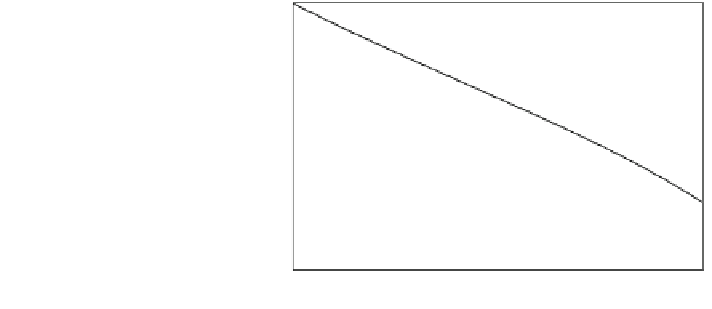Environmental Engineering Reference
In-Depth Information
Fig. 6.7 Ratio of starting to
rated torque. U
s
/U
p
= 1/3,
C
l,max
= 1,a
max
= 5.78. The
vertical axis is logarithmic
10
-2
c
max
= 0.1, N = 3
no limit on c
10
-3
c
max
= 0.1, N = 2
6
7
8
9
10
11
12
13
14
Rated tip speed ratio,
p
to pay to starting behaviour even when the turbine has a low resistive torque.
Furthermore, the reduction in torque when the blade chord is limited again shows
the significance of the hub region in generating the starting torque.
6.3 Analysis of Starting
Obviously a stationary blade cannot extract power, which is a consequence of
neglecting a and a
0
, but an accelerating one must at least extract its own rotational
kinetic energy. However, it is tempting to generalise the analysis of
Sect. 6.2
for
the whole starting sequence by assuming that no power is extracted, a and a
0
remain negligible, and the aerodynamic torque acts solely to accelerate the rotor.
These assumptions will remain valid for small values of the ratio of the rotor
kinetic energy at the end of the idling period, 1/2NJX
2
to the kinetic energy of the
wind that passed through the rotor during time T
s
,1
=
2qU
s
pR
2
T
s
. For the sequence
in Fig.
6.4
, with NJ = 0.43 kg m
2
from Table
6.1
, X = 75 rpm, U
s
= 4 m/s, and
T
s
= 80 s, the ratio is 0.0014. Figure
6.8
shows that T
s
scales with U
s
so that
eventually, the assumption of minimal power extraction must break down. How-
ever, the designer's aim is to achieve starting at the lowest sensible U
s
so the
assumption is retained.
Unsteadiness can alter the lift and drag of the blade elements because the
magnitude of the velocity and the angle of attack are both changing with time. To
estimate their effects, consider only the latter, which can be gauged from the
''reduced frequency'', k
¼
p ac
=
2
ð
where a
¼
da
=
dt is the rate of change of the
angle of attack measured in rad/s, see, for example, Sect. 8.4 of Leishman [
3
]. For
a rotating blade, U
T
is
q
U
2
þ
r
ð
2
q
1
þ
k
r
U
T
¼
¼
U
ð
6
:
13
Þ
From the geometry of Fig.
6.6
,























































Search WWH ::

Custom Search